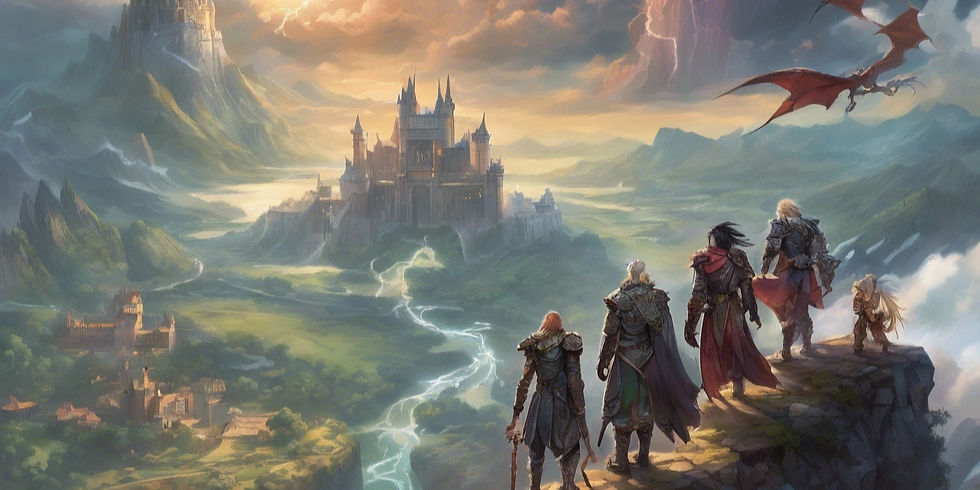Running High-Level Adventures in D&D and other TTRPGs
- Lorelis Eathalen

- Sep 18, 2024
- 4 min read

Running High-level adventures in TTRPGs presents unique challenges that set them apart from lower-level campaigns. Characters wield immense power, often defying typical game mechanics and story structures. As a Game Master (GM), it’s crucial to adapt your approach to keep the game balanced, engaging, and full of excitement. Here are some tips for navigating the complexities of high-level play.
Escalate the Stakes and Challenges to Run High-level Adventures
At high levels, characters have access to potent abilities and gear that trivialize standard encounters. Therefore, GMs need to increase the stakes of their adventures. In a fantasy setting, this might involve confronting an ancient lich who commands undead legions and has hidden their phylactery across several planes of existence. In a sci-fi game, the stakes could be stopping a rogue AI from taking over an intergalactic network, requiring the party to infiltrate multiple space stations to shut it down. For horror TTRPGs, ramp up the terror with cosmic horrors or eldritch entities that threaten reality itself, introducing elements like sanity checks and moral quandaries to challenge even powerful investigators.
Balance Encounter Design
High-level characters can deal massive amounts of damage, but they can also withstand a lot. Craft encounters that are dynamic and multi-layered. In a fantasy setting, instead of a single powerful dragon, introduce an encounter that includes the dragon’s minions, environmental hazards (like lava flows or crumbling terrain), and time-sensitive objectives (such as rescuing a captive before the lair collapses). For a sci-fi setting, space combat might involve fighting off multiple enemy ships while navigating an asteroid field and managing ship systems. In a horror game, encounters can involve investigative scenes with overlapping threats: the characters must uncover clues in a haunted mansion while evading traps and supernatural entities.
Embrace Creative Problem-Solving
High-level characters have a wealth of powers that allow them to bypass traditional obstacles. Instead of restricting their options, embrace their creativity. In a sci-fi game, if the party uses advanced tech to hack a planetary defense system, let it work but introduce new consequences, like triggering an alert to a powerful adversary. In a horror TTRPG, players might use forbidden rituals to combat a monstrous entity, but doing so risks permanent corruption. Reward their ingenuity but keep the narrative tension alive by ensuring their actions ripple through the story.
Evolve Story Complexity
By high levels, characters have likely amassed allies, rivals, and a reputation. Use this narrative richness to weave complex plots. In fantasy settings, their past choices might shape kingdoms' fates. In sci-fi campaigns, their actions could alter galactic politics, drawing the attention of shadowy organizations. For horror adventures, delve into the psychological impacts of their past battles against the supernatural. High-level campaigns thrive on stories that are not just about tougher foes but about the intricate worlds and consequences the players have shaped.
High-level adventures can be daunting, but with creativity and an eye for complexity, they become some of the most memorable experiences in TTRPGs.
Words from Beyond the Veil
These videos, while specific to D&D, have tips that can also be applied to other TTRPGs:
Web DM shares strategies for DMs to enhance tier 4 gameplay. Key advice includes adopting a flexible mindset, practicing improvisation, and focusing on improving DM skills rather than solely on player characters.
The DM Lair shares strategies for effective high-level gameplay, focusing on high stakes, balanced encounters, and engaging villains. The advice helps DMs create memorable experiences while ensuring players face meaningful challenges.
Kapslash says that high-level D&D campaigns require careful management to keep players engaged. Tips include keeping the party size small, creating memorable villains, and balancing combat with other challenges. DMs should maintain a sense of wonder.
Crucibles to try out while you run your next session
Increase the stakes with multi-part objectives: Design an encounter where the players must tackle multiple objectives simultaneously. For example, create a mission where they must defeat a powerful villain while also stopping a ritual, rescuing hostages, or preventing environmental hazards. Introduce this into your next session to see how players manage high-stakes, multi-layered tasks.
Create dynamic and layered encounters: Run an encounter where enemies aren't the only threat. Introduce environmental hazards like crumbling terrain or dangerous weather conditions. In a sci-fi game, add technical challenges, such as managing ship systems while under attack. See how players adapt.
Encourage creative solutions: Plan a scenario that encourages players to think outside the box. Allow them to use their high-level abilities in ways that could solve problems or bypass traditional obstacles, but introduce unforeseen consequences. For example, let them disarm a trap with magic but attract the attention of a more powerful enemy.
Add moral dilemmas or psychological consequences: Introduce a situation where players must make difficult moral choices. For example, in a horror game, offer them a chance to defeat a powerful entity, but only by sacrificing an innocent NPC. Explore how players react to these decisions and whether they choose power over morality.
By experimenting with these exercises, GMs can hone their skills in running high-level campaigns that challenge players in exciting and dynamic ways.



Comments